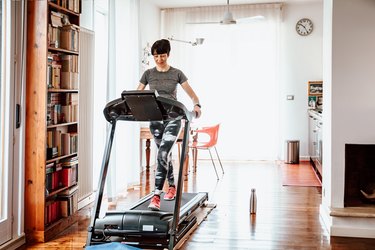
You hop on your treadmill after a long day at work to get a much-needed stress-busting sweat session in, only to have it suddenly stop on you a few minutes later. Treadmills like ProForm and NordicTrack are expensive, and it definitely is a bummer when an investment like that isn't working correctly.
A treadmill that stops running after starting the workout can mean something's wrong with the belt, platform, motor or speed controls.
Video of the Day
Video of the Day
While this situation is incredibly frustrating, you don't need to panic just yet. Depending on the make, model, age and condition of your machine, the problem might be something you can repair or handle yourself, like resetting the machine.
So, if you're wondering, why does my treadmill keep stopping, this guide will help you with the basics of troubleshooting your treadmill when it abruptly stops and won't turn back on.
1. Check the Power Cable and Outlet
Some treadmill power problems can be as simple as a loose cord. Check the power cable to ensure it's tightly inserted in the wall socket.
Treadmills have specific power requirements that the manufacturer specifies in the owner's manual. Most manufacturers recommend plugging your treadmill into a single-outlet surge suppressor with certain voltage suppressor ratings. Plug the surge suppressor into a grounded outlet on a dedicated, 120-volt circuit, per Horizon Fitness, a fitness equipment manufacturer. (A dedicated outlet means no other electronic devices are plugged into it.)
Most treadmills are not compatible with a GFCI outlet. "A GFCI outlet acts like a surge protector," according Horizon Fitness. "This could cause issues including the treadmill tripping a breaker, the motor not receiving the full voltage to function properly and causing a hot motor or burning smell from your treadmill."
If your treadmill isn't properly plugged in, power surges and fluctuations in your house can damage your machine, causing it to not run.
2. Check the Safety Key
One main safety feature on treadmills is the safety key. To protect the user from injury, a treadmill won't run if the safety key isn't in the console correctly, according to Treadmill Doctor, a repair company for fitness equipment. So, if your treadmill won't start, make sure the safety key is fully inserted in the console.
Check to see if your safety key wiggles around when you place it in. "If it does, you could risk having it dislodge during your workout, which would cause the treadmill to stop unexpectedly," per Treadmill Doctor.
You can also test your safety key by gently tugging on it, per Treadmill Doctor. It should remain in place. If it pops out easily, it may need to be replaced.
3. Check the Belt
If your treadmill stops while running or walking, there are several potential causes that have to do with your treadmill's belt (the moving piece of material that you walk or run on), according to Treadmill Doctor.
Your Belt May Need Lubricant
If the belt is sticking, the first step is to check the lubrication. All treadmills need some form of lubricant between the belt and the deck — the section under the moving belt. There are many types of lubricants; the correct one is designed to work with the materials used in your machine.
Some treadmills have a "self-lubrication" system, which is a reservoir of fluid that applies the correct amount as needed. On basic treadmills, the lubricant is applied manually. If you're unsure which type of lubricant your treadmill needs, check with the manufacturer or a specialty supplier.
Your Belt Rollers May Need Adjustment
The belt may stop when you step on it if the distance between the two belt rollers needs adjustment. (Belt rollers are long, tube-shaped parts the treadmill belt wraps around.) Either the belt has stretched, causing it to lose its grip on the rollers or the adjustable roller at the rear of the treadmill has moved.
Both situations are quickly fixed by adjusting the bolts that hold the roller in place. You'll need a tool called a hex spanner, which is normally supplied with the treadmill, to loosen, move and then tighten the rear roller.
The front roller is connected to the motor. The roller at the rear of the machine is adjustable. Locate the bolts at the rear of the treadmill. These may be under plastic covers. With the treadmill turned off and unplugged, turn the left and right bolts a quarter turn clockwise, per Horizon Fitness.
Next, turn the treadmill on and test it to see if the adjustment has tightened the belt and fixed the problem; if not, repeat the process of turning the machine off and turning the bolts another quarter turn on each side.
Tip
Don't be tempted to just tighten up the bolts as firmly as you can, as this may prematurely stretch the belt. Treadmills are designed to be adjusted progressively. This feature means that a belt can be adjusted a number of times before requiring replacement.
Adjust both the left and right bolts equally, as turning one more than the other will eventually move the belt off center.
Your Belt May Be Fraying
Observe the belt to detect any fraying. When a belt becomes worn, the frayed area creates more friction and resistance, per Horizon Fitness. This increases the heat and power requirements on the motor. The treadmill detects the problem and shuts off the power. If the belt is loose, use an Allen wrench to tighten the tension by adjusting the screws on the back of the treadmill. Turn the screws 1/4 inch clockwise to tighten the belt.
Your Belt May Be Too Tight
If the belt is too tight, it could cause enough tension that the motor can't turn the belt, per Treadmill Doctor. This is most likely the cause of your belt not moving if you recently adjusted the belt tension due to slippage. Lift the edge of the belt. If you can't raise it at least 2 to 3 inches off the walking deck, the belt is too tight. Follow the directions in your owner's manual for loosening the belt. You will need an Allen wrench to loosen the rear roller adjustment bolts.
Your Belt May Have Shifted
A treadmill belt can shift to the right or left over time, per Treadmill Doctor. If it shifts enough, this may cause the belt to stop moving. Stand at the back end of your machine and inspect the belt. If it has shifted, you will need to center it by turning the rear roller adjustment bolts. These bolts adjust both the tension and the centering of the belt. Follow the instructions in your owner's manual that explain which of the two bolts you need to tighten or loosen to shift the belt back to the center.
4. Check Under the Hood
Loose or broken parts under the motor hood of your treadmill can cause the machine to not start. If the console lights up, but the treadmill won't start, the motor controller could be damaged.
Loose wires under the motor hood or in the console can cause your treadmill not to start, per NordicTrack Fitness. Turn off and unplug your treadmill and remove the screws and lift off the motor hood. Look around for any obvious damage, burns, loose or broken wires.
5. Check Your Console Wires
Horizon Fitness recommends checking the console wiring if your treadmill belt doesn't move. The console wire connects to the main wire that runs down the inside of the treadmill upright to the motor board.
Make sure the connection between the two wires is secure. The connectors usually snap into each other. Turn off and unplug your treadmill, then disconnect and reconnect the wires. Make sure the wire that runs through the upright isn't pinched or twisted.
6. Contact the Manufacturer
If you've taken the steps above and still can't find the source of the problem — or you've identified it but aren't able to fix it yourself — contact your treadmill's manufacturer.
If your treadmill is still under warranty, the manufacturer may cover the cost to repair your machine. If you attempt to fix the treadmill yourself and it is under warranty, you may void the warranty. In this case, only perform the troubleshooting tips listed in your owner's manual or recommended by your manufacturer.
- Treadmill Doctor: "Walking Belt Is Worn"
- Horizon Fitness: "TREADMILL ELECTRICAL REQUIREMENTS"
- Treadmill Doctor: "Troubleshooting a Treadmill That Won't Turn On"
- Horizon Fitness: "RUNNING BELT ADJUSTMENTS"
- Treadmill Doctor: "What is the Best Way to Fix a Treadmill Belt Centering Problem?"
- NordicTrack Fitness: "No Console Power"
- Treadmill Doctor: "My Treadmill Loses Power When I Step on the Belt"


